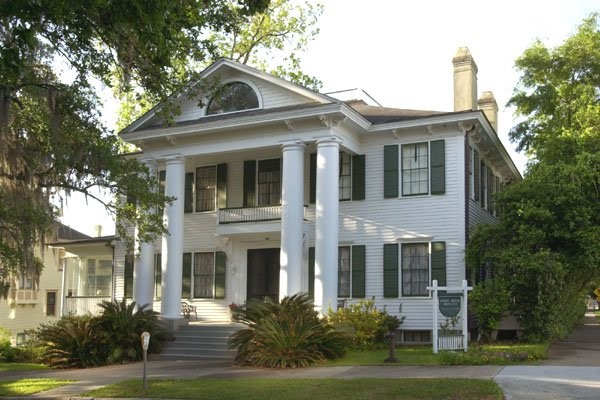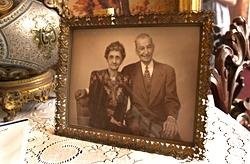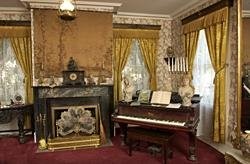Knott House Museum
Introduction
Text-to-speech Audio
Named after prominent Florida civil servant William Knott (1863-1965), this historic home was originally built in 1843 and is now a museum run by the Museum of Florida History. Knott served in a number of high positions in the state government including as tax auditor, comptroller, and state treasurer. He and his wife, Luella, acquired the house in 1928 and remained for the rest of their lives. The house is also significant for its association with its builder, George Proctor, who was a free African American carpenter in Tallahassee. After the Civil War, Union Brigadier General Edward M. McCook (1835-1909) occupied the house. On May 20, 1865, he set free the enslaved people in the region by announcing that the Emancipation Proclamation was in effect. The Knott House is included in the Park Avenue Historic District, which was listed on the National Register of Historic Places in 1979.
Images
The Knott House was originally built in 1843 by free African American carpenter George Proctor. It is named after William and Luella Scott, who bought it in 1928 and remained for the rest of their lives. It is now a museum operated by the Museum of Florida History.

William and Luella Knott

The Living Room

The Study

Backstory and Context
Text-to-speech Audio
Thomas and Catherine Hagner
The first residents to live in the house were attorney Thomas Hagner and his wife, Catherine. Hagner moved to Tallahassee from Maryland in 1838 to establish a practice. At the time, his uncle was a territorial Supreme Court judge (Florida became U.S. territory in 1821) and it is possible he encouraged Hagner to come to Florida. Hagner's practice was successful, enabling him and his law partner to purchase eight enslaved people in 1842, who they likely rented out to others (Hagner owned one to three enslaved people at different times as well). That year he bought 78 acres which included the Knott House as Proctor had originally constructed it. Hagner then expanded the house. He married his wife, Catherine, in 1844 and they had two children. Hagner, who was often sick, died in 1846. Catherine moved to South Carolina shortly thereafter (and later moved to Maryland) but continued to own the house.
Edward McCook
Who lived the house during the next several years is unclear but the next notable occupant was Edward McCook, who would serve two terms as territorial governor of Colorado. McCook was born on June 13, 1833 in Steubenville, Ohio and was the eldest son of John and Catherine McCook. He was locally educated and in 1849 moved to Kansas where he studied and practiced law. By 1859 he moved from Gregory Gulch to Central City and became a prominent lawyer. That year, he was elected as first delegate under the control of the Kansas legislature. Soon after the Civil War began, McCook became a secret agent for the federal government. However, he soon joined the U.S. Army as a cavalry lieutenant and became a captain with the 2nd Regiment Indiana Volunteer Cavalry. On May 13, 1865 the last of the mobile Confederate troops of the state of Florida under Colonel George Washington Scott surrendered to McCook, who immediately occupied the Knott House. One week later, during a ceremony in Tallahassee, McCook announced the Emancipation Proclamation to be in effect. After the war, McCook resigned and President Andrew Jackson appointed him as minister to the Hawaiian Islands, a position he served until 1868.
In 1883, Cathrine Hagner sold the house to Dr. George Bretton (c.1824-1896), who renovated it. He also opened a practice in the house. His widow sold it to Henrietta Wood in 1903. Wood lived here part time; during summers she visited family in Kentucky. She sold the house to another widow, Caroline Scott (born c.1861), in 1919. Scott lived here and rented out rooms as well.
William & Luella Knott
Scott sold the house to the Knotts in 1928. They made some small renovations but added large columns to the front facade. As stated above, William Knott served in various positions for the State of Florida as tax auditor, comptroller, and state treasurer. In 1917, he ran for governor as a Democrat but lost in a close election. From 1921-1923, he served as administrator of the state hospital in Chattahoochee. The governor appointed him for a second term as state treasurer in 1928 after the previous treasurer died. Luella (1871-1965) was a musician, poet, and a social causes advocate. She was very fond of poetry and affixed her poems to the furniture and decor around the house. As a result, the house became known as “The House That Rhymes.” It remained the in family until their son, Charles, died in 1985. The Historic Tallahassee Preservation Board acquired and renovated the house, which opened to the public in 1992. It was transferred to the Museum of Florida History in 1997.
Sources
"About the Knott House Museum. The Museum of Florida History. http://museumoffloridahistory.com/about/sites/. Accessed 3 October 2018.
"Before the Knotts." The Museum of Florida History. https://www.museumoffloridahistory.com/visit/knott-house-museum/before-the-knotts.
"Edward Moody McCook." Colorado Encyclopedia. Accessed January 4, 2023. https://coloradoencyclopedia.org/article/edward-m-mccook.
Friend, Sandra & Keatley, John. Explorer's Guide North Florida & the Panhandle (Third Edition) (Explorer's Complete). The Countryman Press, Mar 30, 2018.
All images via the Museum of Florida History
